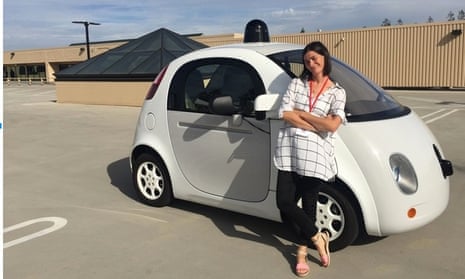The room went quiet, as if everyone had just held their breath. Sergey Brin, Google’s co-founder, had just walked in wearing Crocs. I think it was the fact it was billionaire Brin, rather than the Crocs. Brin has the loosest of schedules and works on whatever takes his fancy. This morning it was self-driving cars. Regularly deferring to his engineers for the detail, Brin was there to emphasise how important and impressive the technology is, as if we needed reminding.
I asked Brin how he planned to humanise the technology, how to take it beyond Google’s privileged and pro-technology bubble into a real world where citizens are more sceptical and less trusting. He looked disappointed with the question.
“I’d explain to them the benefits. Our mothers might be having a hard time driving and still want to get around. It’s important to have that mobility, so I’d just explain it’s an affordable way to get from here to there that is safe,” he said, and quickly moved on to more comfortable questions about the American love affair with the automobile. If something as brilliant as Google is asking you to put your life in the hands of its software, then just do it and stop asking stupid questions about human beings.
The car oozed to a halt in front of me. I opened the oversized door, put my bag on the floor and took a seat next to my fellow journalist, Dave. The inside had more floorspace than most London toilets, and a big storage bucket where the steering wheel and dashboard weren’t. Instead we had a small screen showing our route, a few buttons to open the windows and a large red panic button. “No photos or video, and please don’t remove your seatbelts,” our chaperone instructed. That sounded ominous, but we trusted she hadn’t programmed a route on this rooftop test circuit to dispose of two tiresome British journalists.
Google’s prototype self-driving electric cars, of which the company had 50 built in Detroit, have been driving on the streets of Mountain View, California, since June. Designed, I suspect, to look as unintimidating and benign as possible, the cars verge on cutesy, in softly rounded white plastic with large headlamp eyes and big windows. But Toytown they are not, with a sophisticated triage of 360-degree lasers, radar and cameras that scan its surroundings as it drives, creating a complex 3D image of its environment up to three football fields away.
Analysing that environment, it identifies and categorises vehicles, cyclists, pedestrians, traffic signals and the road network, calculating movement and response according to its knowledge of road rules and applying a conservative driving style. Road safety statistics inform that driving style; most accidents at intersections happen in the first second after the lights turn green, so the car waits one second before pulling away.
The strongest case for self-driving cars is safety, its logical, programmed movement also means vehicles can be centrally controlled, rerouting traffic away from congestion. Since the project started in 2009, Google has driven most of its 1.2m hours of tests in a small fleet of customised Lexus autonomous cars. As of July this year, there had been 14 accidents but all had been caused by human error, not by the software. Around 33,000 people die in traffic accidents in the US every year; Google says self-driving cars will reduce that number significantly. The opportunities are, indisputably, immense.
The hard sell for Google will be winning over generations of people who feel safer being in control of their vehicle, don’t know or care enough about the technology, or who simply enjoy driving. Yet most people who try a demo say the same thing: how quickly the self-driving car feels normal, and safe. As the head of public policy quipped, “perhaps we just need to do demos for 7 billion people”. Google’s systems engineer Jaime Waydo helped put self-driving cars on Mars while she worked at Nasa; it may well be that regulation and public policy prove easier there than on Earth.
And before it can get to the public, Google has to get through the regulators. In taking on the auto industry, Google has some mighty pitched battles ahead, not least the radical changes it implies for the insurance industry (who will find the number of accident claims dropping sharply), car makers (who will become partners with Google to equip their autonomous cars) and the labour issues of laying off a whole class of drivers, from cabs to haulage. But Google has already pre-empted the scrutiny of regulators, inventing a new parent company called Alphabet that will allow its specialist businesses to be built more independently. And Google is already the third biggest lobbyist in the US, spending $10m in the first half of 2015 alone.
There’s no reason why Brin himself should have the answer on how to take his company’s technology to the masses. Our expectations are defined by the myth of the founder, and we like to buy into the idea that these be-Crocced geniuses have some all-knowing power, where in fact they were privileged, smart and got lucky. But that is increasingly the biggest challenge for technology firms, in not only being able to explore and exploit the opportunity of technology using their significant resources and brainpower, but in knowing how to win the confidence of citizens. Would you feel safe in a self-driving car?

